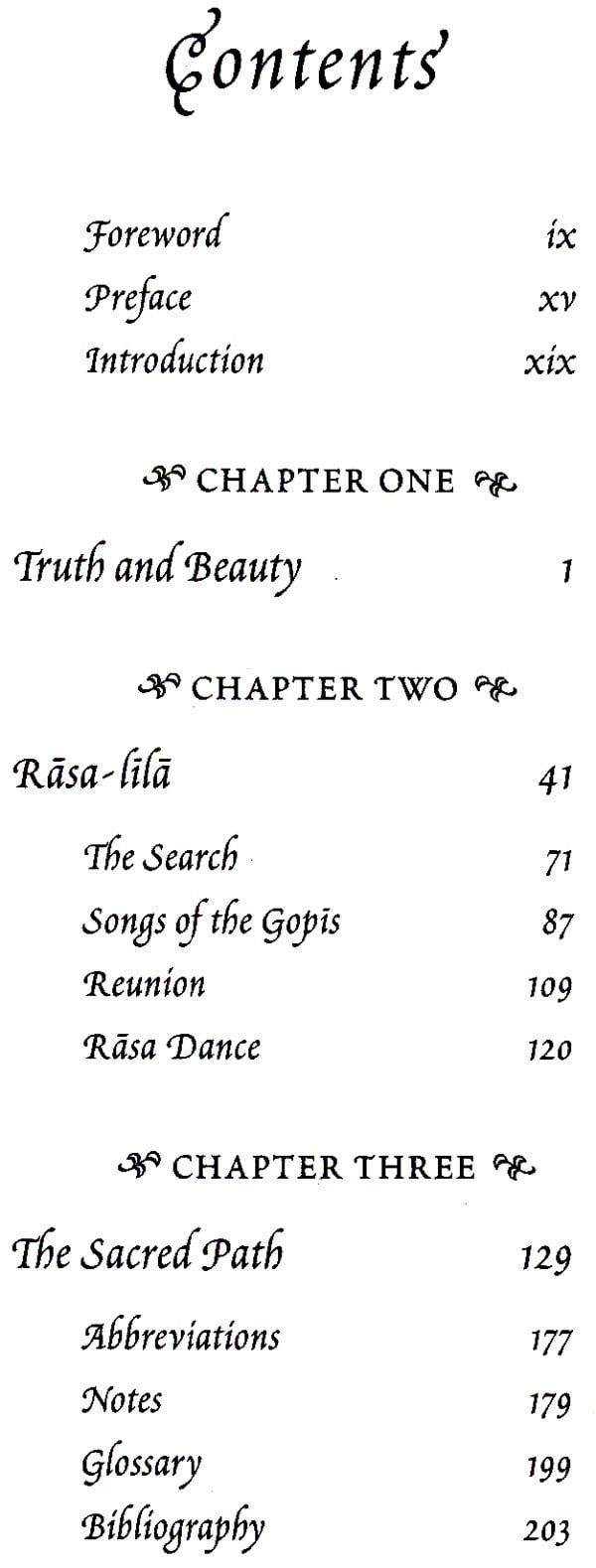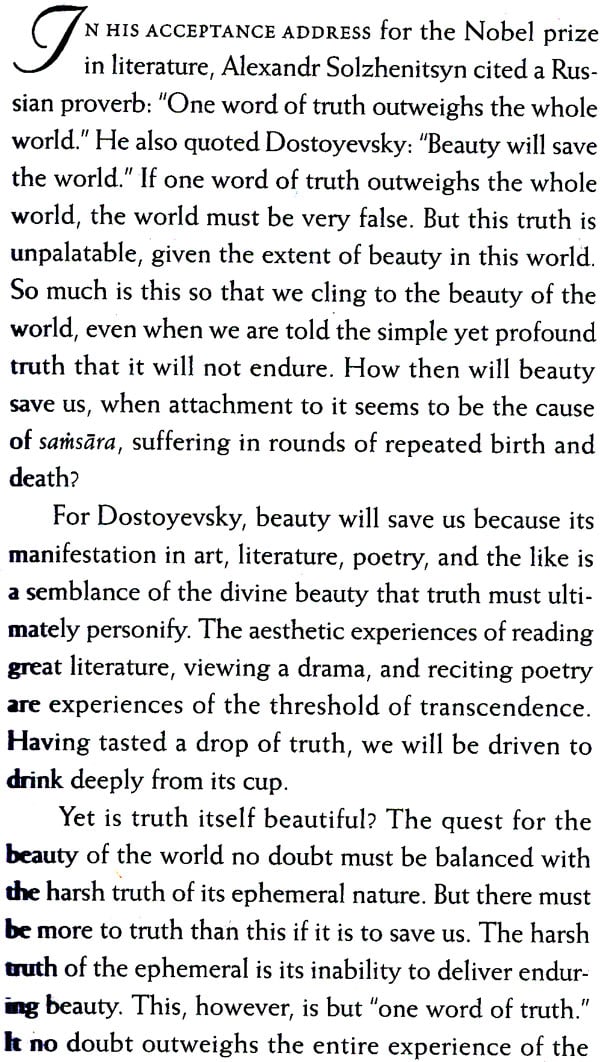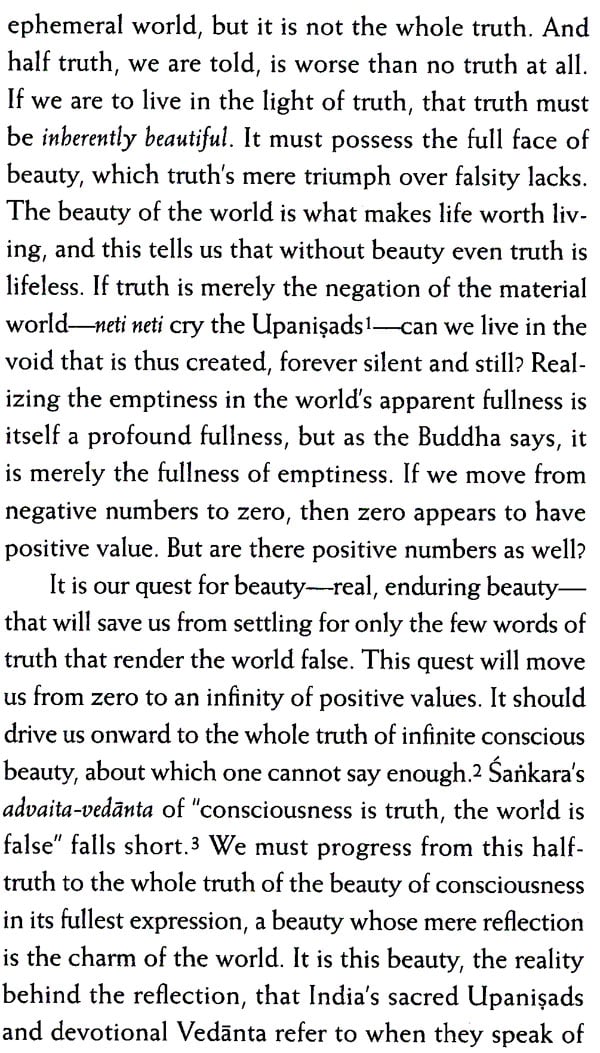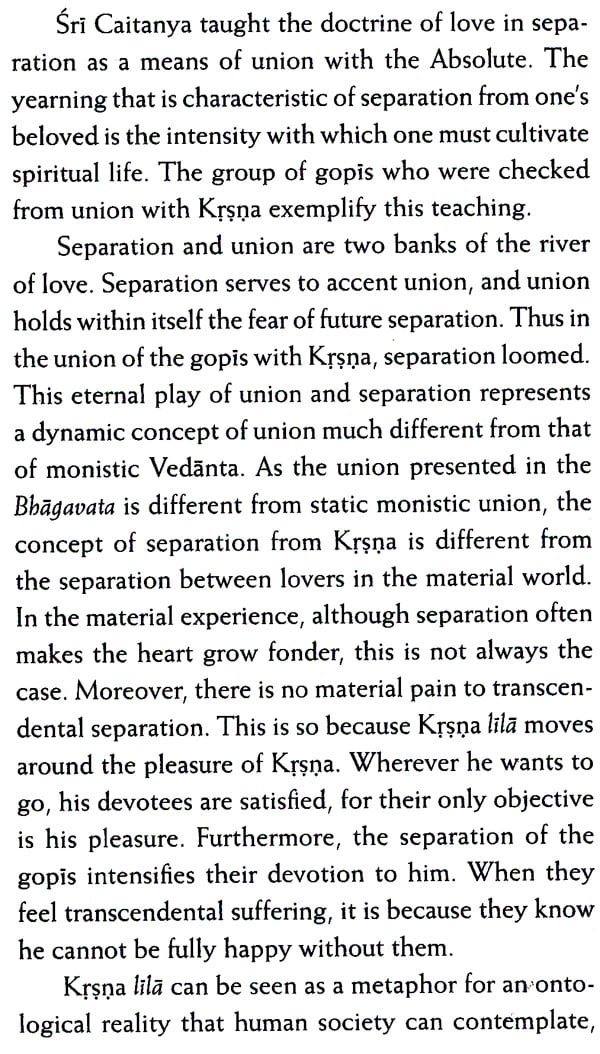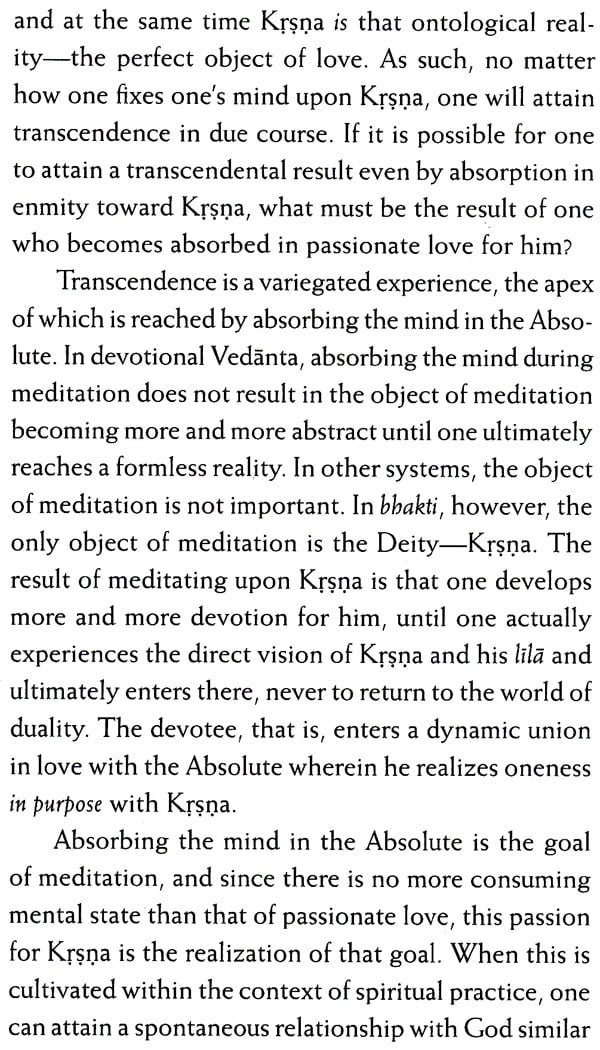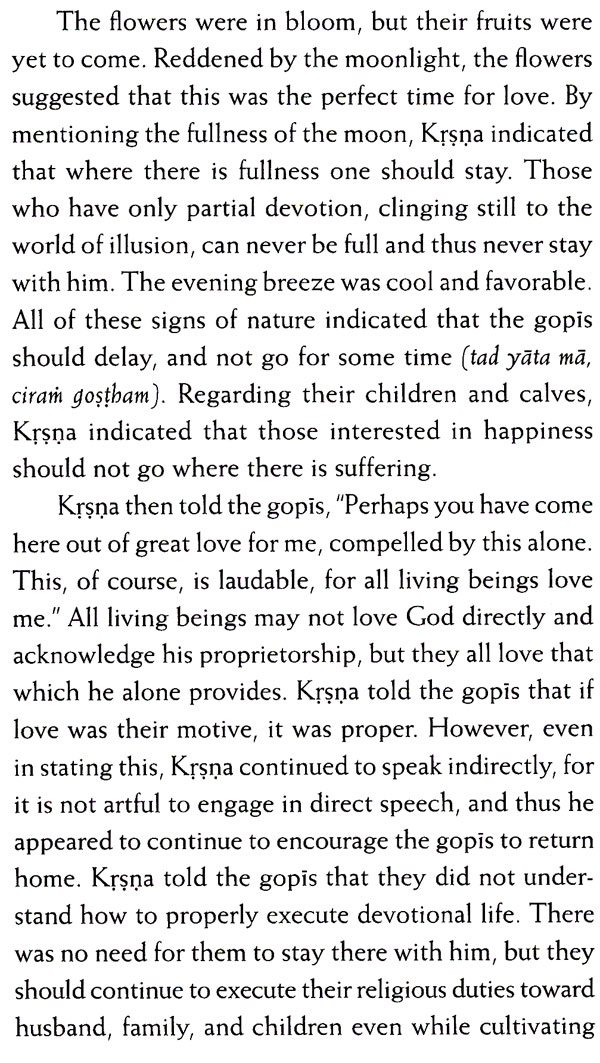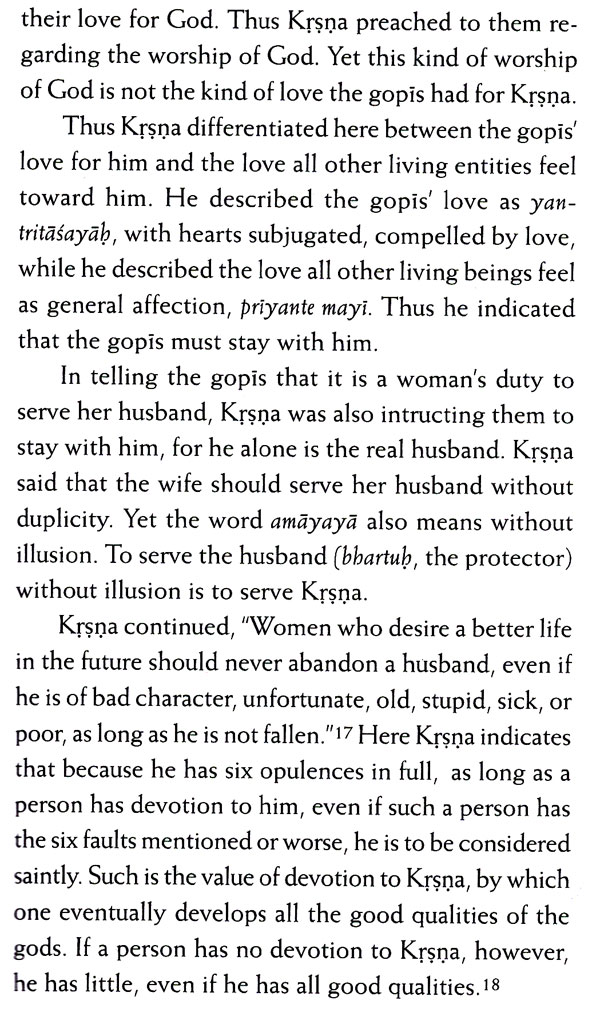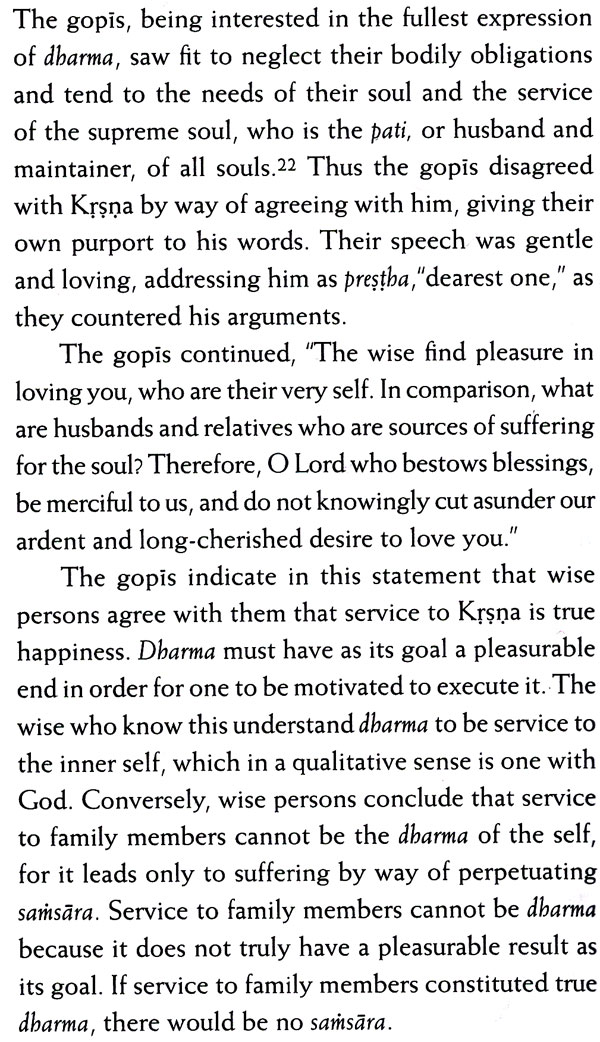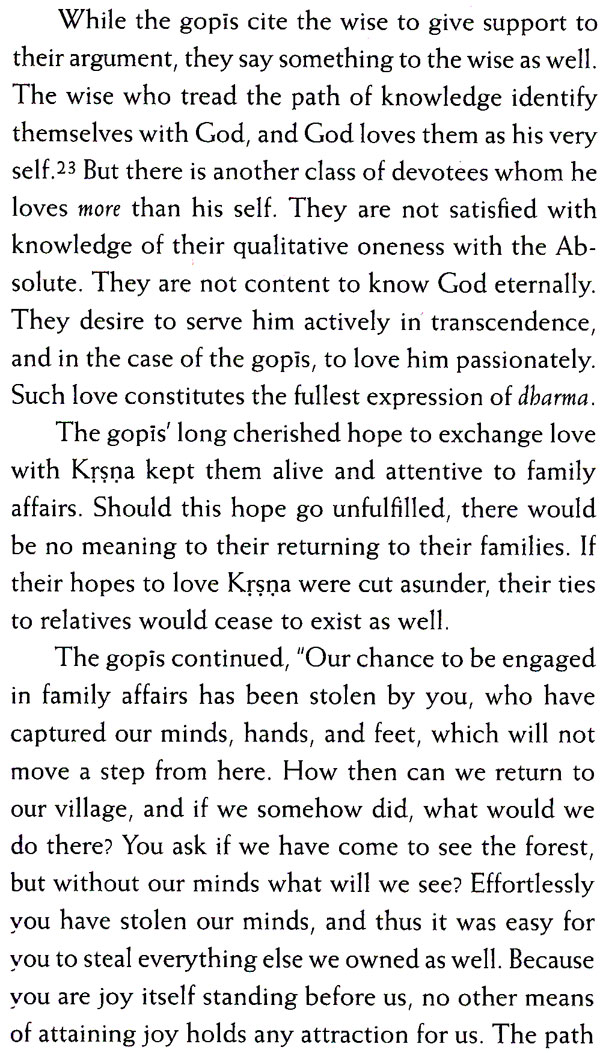
Aesthetic Vedanta (The Sacred Path of Passionate Love)
Book Specification
| Item Code: | NAQ849 |
| Author: | Swami B.V. TRIPURARI |
| Publisher: | Sri Caitanya Sangha |
| Language: | English |
| Edition: | 2014 |
| Pages: | 238 |
| Cover: | PAPERBACK |
| Other Details | 7.50 X 4.80 inch |
| Weight | 260 gm |
Book Description
The playful dance of beauteous love (rasalila) between divinity and humanity is one of the most sublime metaphors of India. It is the leitmotif of the devout followers of Lord Krsna, whose dance with the enchanted gopis (cowgirls) of Vrndavana is remembered in exquisite Sanskrit in the Srimad Bhagavatam (also called Bhagavata Purana). Here we can read of the heart-rending love spell he cast upon the villagers by his youthful beauty, unsurpassed charm, and extraordinary radiance, which irresistibly drew the gopis closer and closer to him. Seeking to kindle their passionate longing for him still more, he played his magical flute whose unearthly sounds bewildered their minds, leaving in them only a single burning desire: to be absorbed in Sri Krsna, heedless of all else.
The divine Gopala ("protector of the cows/earth"), who had incarnated to restore the moral order (dharma) and to light the flame of unconditional love in mature souls, embraced all equally. At the climax of Krspa's love play, he, assuming the role of the lover perfectly, danced a dance of ecstatic abandon with all the gopis simultaneously. And yet, each gopi was so flawlessly merged with him that they all were completely oblivious of each other, seeing only their beloved.
One gopi, the lovely Radha, has been singled out by the sages who recounted this great mythic dance because of her spiritual maturity. Her all-consuming, unselfconscious love for the Lord has become the grand ideal guiding those who, knowing of the ultimate secret of the heart, seek the divine through the agency of feeling. The creative, erotic tension between Radha and Krsna has served many generations of spiritual practitioners as a potent metaphor for their own inner struggle, yielding both the joy of union and the despair of apparent separation and leading to ever more profound love. The powerful myth of the rasa-lily is true for all times, because it captures the unique relationship that eternally exists between the divine and the human heart overflowing with transrational, rapturous love for the supreme person, the source of all beings and things.
As is the case with any true myth, the rasa-lila can be understood on many levels. The present book focuses on the aesthetic message: truth is beautiful and beauty is truthful. The West's encounter with India's spiritual heritage has largely occurred through the philosophical lens of Advaita Vedanta, notably the radical nondualist metaphysics of Sankara (eighth century c.E.). While this lens offers many intriguing insights, it does not permit us to encounter the full range of Indic wisdom. In fact, it has considerably blinded us to the fact that living Vedanta has little to do with Sankara’s abstract system, which emphasizes discerning wisdom (vijinana) but pays virtually no attention to the power of feeling, specifically love/devotion (bhakti).
He higher one climbs on the ladder of spiritual love, the more difficult it is to recognize that love, for love by its very nature hides itself. The rasalila is perhaps the best example of this. It is a very spiritually elevated account of the secret love affair of the Absolute. Yet outwardly it appears to be a description of humanity's lower nature.
The rasalila was originally revealed to a wide audience by Sukadeva Goswami, a sixteen-year-old adept who wandered the countryside naked, oblivious to the external world. He was the ideal person to speak about this confidential affair of the Absolute, for everyone knew that he had no interest in mundane life. Although the rasalila may appear to the uninformed to be an account of a material affair, sukadeva's keen interest in it demonstrates its exalted spiritual nature.
Thousands of years later, Sri Caitanya commissioned his principal disciples to broadcast the message of the rasalila to the entire world. While preoccupied with the love of Radha and Krspa, he himself maintained the highest moral character. The character of his disciples was also beyond reproach. Caitanya maintained that the love of Radha and Krspa is so pure that hearing about it can purify the hearts of even the vilest persons.
Sri Caitanya is considered to be a combined incarnation of Radha and Krsna, descending to the world to distribute the highest divine love. About him it is said:
"The brightest jewel
of sacred love in passion
is never given at any time.
Yet the most merciful
in this age of quarrel
gives it out to all
May that golden-lion son of Saci
manifest in your heart.",
This book was written in pursuit of the import of this verse. It seeks to inform the world, and especially the literate West, as to the significance of rasalila as seen through the eyes of Sri Caitanya. In so doing, it appropriately brings attention to Sri Caitanya, and thus the spiritual passageway to the mysterious land of love. It is there that the rasa-lila is perpetually performed.
The cover art for this book was done by the renowned Mahaveer Swami of Bikaner, Rajasthan. It depicts the gopis singing in separation from Krsna as found in the Gopi-gita. Mahaveer's sensitive insights have contributed progressively to Indian miniature painting while retaining the tradition's essence. It was a pleasure to work with him and to see him embrace the ideals of the devotional path of Sri Caitanya.
THERE IS A FINE LINE between myth and reality. The word myth can mean a story that expresses a certain truth allegorically or it can simply mean a falsehood. Since the time of Freud and Jung, it has become popular to search for significant psychological truths in myths. Yet even the most powerful myth is at best only an allegory; it is not itself truth in the sense of objective reality. It is never a true story.
For most of us, our reality is the world of our mind, informed by data gathered through our senses. This may be our reality, but how real is it? It certainly does not endure. Our instruments of perception, our senses, are imperfect to begin with, and thus the world of our mind informed by them may be more false than real. Hot, cold, happy, sad, good, and bad are mental notions relative to our sense perception. The same day is cold for one and hot for another, good for one, bad for another. We view the world though the glasses of our mental and sensual experience, yet ultimately these get in the way of truly experiencing.
According to Vedanta, that which we presently perceive to be reality is more akin to myth, a falsehood, while we ourselves, the experiencers, are units of reality-souls. The phenomenal world is no doubt real, but our perception of it is false, so false that it causes us to lose sight of our souls. The sense of the loss of soul that permeates our culture serves to underscore the mythical quality of our perception of reality. That which we perceive to be reality is rather an allegory for the true story: it is a reflection of the reality of the Absolute. Upon close examination, we will find that this reflection reveals much to us about ultimate reality.
What then is the true story? The true story is the so-called myth that leads us to our soul and thus to the real. Indeed, that myth may not be a myth at all, just as our mental and sensual perception of so-called reality may not be reality. The religious "myth" of the rasalila that this book is concerned with is the ultimate reality, and not merely a myth. It is an ultimate reality, however, that also confirms the value of humanity, especially its sensual and emotional aspects, for it informs us both that our sensuality has its origins in the Absolute and that the Absolute's expression of such is best facilitated within the human experience. In the rasalila , God enters humanity to celebrate his sensuality, thus confirming the feeling in all of us that our drive for the erotic is not something to be abolished. It is to be redirected away from the world and toward the Absolute appearing in its human-like expressions of Radha and Krsna. In the rasalila, we discover divine humanism-where divinity validates the essence of humanity, and humanity speaks to us about that which divinity must embody in its fullest manifestation.
**Contents and Sample Pages**
